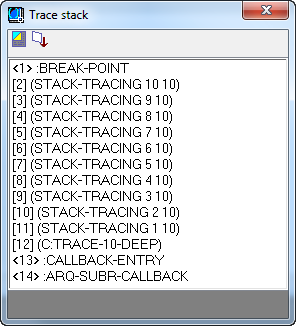A stack element is an individual record or line-item history within a trace stack.
Note: The Visual LISP IDE is available on Windows only.
There are five kinds of elements that may appear within a stack:
- Function call frames show one individual function invocation. They are displayed in the following format:
level (function-name {argument1} ...)Arguments within this listing are displayed not by their local parameter name, but by the values that were actually passed to the function.
- Keyword frames are displayed at the very top and bottom of a trace stack. They are displayed in the following format:
level :keyword - {optional-data}The keyword indicates the type of the frame. The optional-data displays additional information relating to the state of the program.
- Top forms indicate an action that was initiated by typing an expression at the top-level Console window, or from the invocation of a function that was triggered during the loading of a file or selection within a Visual LISP text editor window.
- Lambda forms are placed within a stack whenever a lambda function is encountered within a program.
- Special forms display the invocation of the foreach and repeat functions. The arguments for these functions are not displayed. They are displayed in the following format:
level (function-form ...)
As an example, load the following code in Visual LISP, set a breakpoint as indicated in the code comments, and then start the TRACE-10-DEEP command.
(defun stack-tracing (indexVal maxVal)
(princ "At the top of the stack-tracing function, indexVal = ")
(princ indexVal)
(if (< indexVal maxVal)
(stack-tracing (1+ indexVal) maxVal)
(princ "Reached the maximum depth.") ; place a breakpoint
; at the beginning of
; this line
)
)
(defun c:trace-10-deep ()
(terpri)
(stack-tracing 1 10)
)
The Trace Stack window from the previous sample code looks like the following illustration when program execution is interrupted at the set breakpoint.
